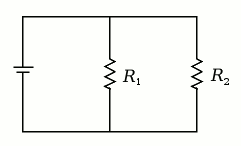 The need to combine resistors in series or in parallel occurs so frequently that it warrants special attention. The process of combining the resistors is facilitated by combining two of them at a time.
The need to combine resistors in series or in parallel occurs so frequently that it warrants special attention. The process of combining the resistors is facilitated by combining two of them at a time.Resistors in Series:
The equivalent resistance of any number of resistors connected in series is the sum of the individual resistances.For N resistors in series then,

Voltage Division Rule:
The source voltage v is divided among the resistors in direct proportion to their resistances; the larger the resistance, the larger the voltage drop. This is called the principle of voltage division.



Resistors in Parallel:
The equivalent resistance of two parallel resistors is equal to the product of their resistances divided by their sum.Consider the circuit in Fig, where two resistors are connected in parallel and therefore have the same voltage across them.

The equivalent resistance of the resistors in parallel is given by:


It must be emphasized that this applies only to two resistors in parallel. R(eq) is always smaller than the resistance of the smallest resistor in the parallel combination.

For example, if four 100 ohm- resistors are connected in parallel, their equivalent resistance is 25 ohms.
Current Division Rule:
Remember Following Equations:The total current i is shared by the resistors in inverse proportion to their resistances. This is known as the principle of current division.

where i is the total current in Circuit.
Notice that the larger current flows through the smaller resistance.
Conductance:
It is often more convenient to use conductance rather than resistance when dealing with resistors in parallel.
The equivalent conductance for N resistors in parallel is

The equivalent conductance for N resistors in Series is

The equivalent conductance of parallel resistors is obtained the same way as the equivalent resistance of series resistors. In the same manner, the equivalent conductance of resistors in series is obtained just the same way as the resistance of resistors in parallel.
Current Division Rule in Terms of Conductance:

Blogger Comment
Facebook Comment